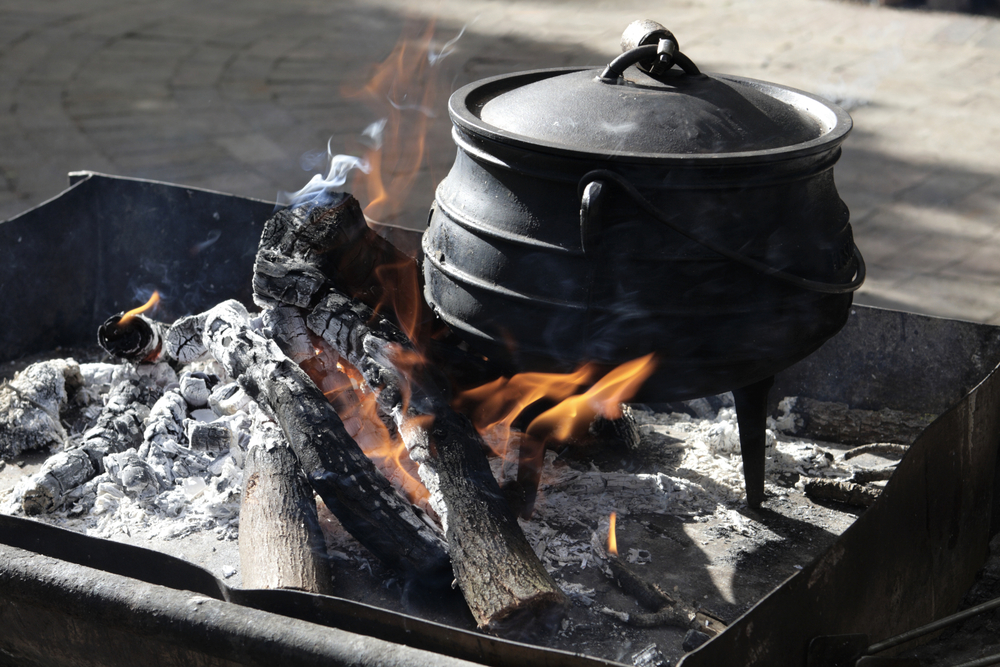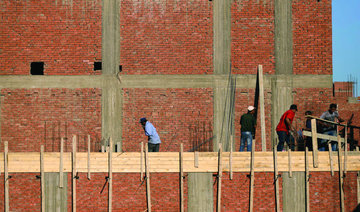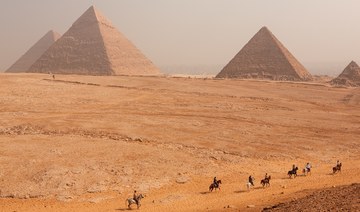CAIRO: Pyramids, Tutankhamun masks, Nefertiti busts — Egypt’s souvenir-makers are pinning their hopes on a new lease of economic life, after tourism was battered by the coronavirus pandemic.
In the shadow of the magnificent Giza Pyramids, Eid Yousri manufactures polyester Pharaonic figurines from a humble workshop erected on the roof of his family home.
“We’ve lost nearly 70 percent of our business,” he told AFP, lamenting the plunge in visitors to one of the seven wonders of the ancient world.
Before the pandemic, “we had about 15 workers — compared to five today,” he said, noting that even the remaining staff were not full-time.
He sells his products from as little as 20 Egyptian pounds (about $1.30) to 200 pounds.
Hundreds of small business owners and artisans have been forced to mothball much of their activity, choked by canceled flights and movement restrictions around the world.
Yousri hopes that foreign tourists are lured back to Egypt in the latter part of the year, “especially Americans,” with some groups from the US expected in September.
In 2019, the last full year before the pandemic struck, tourism made up about 12 percent of Egypt’s GDP.
After a long period of political instability dented earnings, revenues from the sector reached $13 billion that year.
But in 2020, a year when Egypt had initially eyed a further rebound to $16 billion, takings collapsed to $4 billion.
In a recent interview with AFP, Tourism Minister Khaled El-Enani welcomed a partial recovery in visitor numbers.
Around 500,000 have flown in monthly since April this year, more than double the number in January and up from an average of just 200,000 tourists per month in 2020.
On the other side of town, in the narrow and labyrinthine alleys of Khan el-Khalili in Islamic Cairo, tourist Caroline Bucher is on the hunt for “locally made” products to bring back home to her native Dominican Republic.
“We’re looking for hand made and quality souvenirs, that are about local culture,” she told AFP. “It has to be a memory of the trip.”
In a souvenir market that was for many years flooded by cheap Chinese imports, the government is seeking to meet demand for quality products sought out by tourists like Bucher.
On the eastern outskirts of Cairo, a new antique reproduction factory has since March been preparing to capitalize on the much hoped for post-pandemic era.
The factory, named Konouz (treasures in Arabic), produces furniture, statuettes and paintings that retrace four major periods of Egyptian heritage: Pharaonic, Greco-Roman, Coptic and Islamic.
Reproductions, in 1:1 scale or miniaturised, are accompanied by an official government-issued certificate of authenticity.
The vast 10,000 square meter (approximately 107,650 square foot) factory is run by Hisham Sharawi, a retired general, who supervises around 150 workers, painters, cabinetmakers, sculptors and designers.
“We opened a gift shop at the National Museum of Egyptian Civilization” in April, he told AFP.
Other Konouz gift shops will open at museums and key archaeological sites later on.
“When tourists come back, we will be ready,” pledged Ahmed Aboul Gheir, who is also working on the ‘Made in Egypt’ initiative.
Government-driven investment under the scheme totals 80 million Egyptian pounds and focuses on quality production.
In 2015, the ministry of industry prohibited “the imports of goods and products of a popular art nature,” including “models of Egyptian Antiquities” as a protective measure to safeguard its home-grown crafts industry from cheaper foreign competition.
Most of the factory’s replica objects are cast in polyester, plaster or metal. Specialized machines give a “final touch” to the replicas before they are painted by hand or covered with gold leaf.
But the cheaper items created under the initiative also risk crowding out local craftsmen who are unable to produce in such high volumes.
Items at Konouz range from a small amulet selling for 50 Egyptian pounds to a three-meter statue setting back customers thousands of pounds.
Tourism expert Elhamy Al-Zayat calls the government initiative a “smart marketing exercise.”
But he warned against flooding the replica goods market.
“You mustn’t produce too much, otherwise it loses value,” he noted.
Egypt souvenir market pins hopes on tourism resurgence
https://arab.news/wcgsq
Egypt souvenir market pins hopes on tourism resurgence

- Hundreds of small business owners and artisans have been forced to mothball much of their activity, choked by canceled flights and movement restrictions around the world
Oil Updates – crude edges down amid cautious demand outlook

SINGAPORE/HOUSTON: Oil prices edged down in Asian trade on Tuesday, after posting gains in the previous session, as markets remained cautious about global demand growth prospects amid expectations of stronger supplies, according to Reuters.
Global benchmark Brent crude futures slipped 12 cents, or 0.14 percent, to $84.13 per barrel at 9:15 a.m. Saudi time. US West Texas Intermediate crude futures fell 14 cents, or 0.17 percent, to $80.19 a barrel.
Both benchmarks gained around 2 percent on Monday, closing at their highest since April.
“The oil market shifted its focus back to fundamentals, which have been soft for some time,” said BoFA commodity and derivatives strategist Francisco Blanch in a client note, adding that global crude oil inventories and refined product storage in the US and Singapore, among other places, was higher.
Meanwhile, global oil demand growth decelerated to 890,000 barrels per day year-on-year in the first quarter, and data suggests consumption growth likely slowed further in the second quarter, he said in the note.
China’s oil refinery output slipped 1.8 percent from year-ago levels in May, statistics bureau data showed on Monday, as refiners undertook planned maintenance overhauls and processing margins were pressured by rising crude costs.
Markets were also looking out for further clues on interest rates, and how the US demand situation would pan out, as several US Federal Reserve representatives will be speaking later on Tuesday.
Some analysts remained bullish on the price impact of an extension by the OPEC+ group of supply cuts in the near-term.
“The latest guidance provided by OPEC+, as well as their unchanged 2.25 million barrels per day demand growth outlook, signals a stagnation in oil supply growth for 2024 and an apparent downside risk to production in 2025,” said Patricio Valdivieso, Rystad Energy vice president and global lead of crude trading analysis.
“Under these conditions — and the disconnect between the OPEC+ demand outlook and all other agencies — it is hard to remain fully bearish when global oil supply growth appears decimated,” he added.
Recent rebounds in complex refining margins, particularly in Europe and Asia, were also supportive to markets, said Sparta Commodities analyst Neil Crosby.
Refining margins at a typical complex refinery in Singapore averaged at $3.60 a barrel for June so far, compared with $2.66 a barrel in May.
Saudi Arabia climbs to 16th place in World Competitiveness Index

RIYADH: Saudi Arabia’s ongoing economic diversification efforts have propelled the country to the 16th spot in the World Competitiveness Index 2024, up from 17th place the previous year.
According to a report from the Switzerland-based International Institute for Management Development, the Kingdom was ranked 24th in 2022 and 32nd in 2021.
The ascent, supported by Saudi Arabia’s Vision 2030 program, is attributed to significant progress in economic performance, government efficiency, and a business-friendly environment.
The report also highlighted that Saudi Arabia ranked higher than several of its G20 peers, including India, the UK, and Japan, as well as other countries like Italy, Argentina, Indonesia, Brazil, and Turkiye.
Saudi Arabia’s crude production rose to 8.99m bpd in April: JODI

RIYADH: Saudi Arabia’s crude production increased by 13,000 barrels per day in April to reach 8.99 million, according to an analysis from the Joint Organizations Data Initiative.
The data indicated that exports over the same month saw a decline despite this growth, dipping by 445,000 bpd to 6 million compared to March.
The Kingdom’s direct burn of crude oil, which involves using oil without substantial refining processes, increased by 93,000 bpd in April compared to the previous month – an 11 percent year-on-year growth.
The decline in the Kingdom’s crude exports and a marginal rise in production can be attributed to the voluntary cuts adopted by members of the Organization of the Petroleum Exporting Countries and its allies, known as OPEC+.
In March, Saudi Arabia announced the extension of its 1 million bpd cut, initially implemented in July 2023, until the end of 2024.
Earlier this month, the Kingdom’s Minister of Energy Prince Abdulaziz bin Salman said Saudi Arabia will increase its oil production capacity from 2025 to 2027 before returning to a production level of 12.3 million bpd in 2028.
“In 2025, we will have an incremental increase. We will have a bigger incremental increase in 2026 and 2027. And then we will go back to our 12.3 million bpd production in 2028,” said the energy minister.
According to JODI Data, total oil demand in India, one of the largest crude consumers in Asia, slipped by 156,000 bpd in April compared to March.
Similarly, the Asian nation’s total product exports also edged down by 85,000 bpd in April.
On the other hand, India’s overall crude imports rose by 510,000 bpd, marking an 8.1 percent year-on-year increase.
Earlier this month, OPEC said that oil demand globally would rise by 2.25 million bpd in 2024, driven by growth in markets such as China, India, the Middle East and Latin America.
On June 6, speaking at the International Economic Forum in St. Petersburg, Haitham Al-Ghais, secretary-general of OPEC, said that the world will witness continued oil demand growth in the coming years.
“Last year, OPEC’s forecast for oil demand was the best. And all those who criticized OPEC’s forecast kept adjusting their number throughout the year,” said Al-Ghais.
However, the International Energy Agency forecast oil demand growth to slow as the world continues its energy transition journey, although it noted that there would be growth of 1 million bpd in 2024.
Saudi developer Al-Othaim Investment launches new cruise ship in Hail

RIYADH: A five-star hotel is part of a new cruise ship set for Saudi Arabia’s Hail region, local real estate developer Al-Othaim Investment has announced.
The new project, also referred to as Al-Othaim Cruise Hail, is built on a total area of 77,000 sq. m. and includes a shopping mall, 276 residential units, 16 luxurious palaces, and multiple entertainment spaces.
Moreover, the planned hotel on the ship contains 120 rooms and 156 apartments, as well as office spaces on six floors covering an area of over 9,000 sq. m.
The company said in a post on X that this move falls in line with its expansion strategy, which aims to launch several projects in various regions of the Kingdom.
“Our staff of 4,000 young Saudi men and women serve the passengers the recreational services,” the company said in its post.
The new development is also projected to contribute significantly to sustainable development, achieving the nation’s Vision 2030 goals and enhancing Saudi Arabia’s position as a leading global investment center.
Additionally, the planned cruise ship aligns well with the ongoing encouragement of Prince Abdulaziz bin Saad, the governor of the Hail region, to support the growth and development process in the area and to enhance its position as a leading investment destination.
The project also occurs alongside the continuous support for the private sector from the Saudi Minister of Municipal and Rural Affairs and Housing, Majid bin Abdullah Al-Hogail, and his dedication to creating an attractive investment environment throughout the Kingdom’s various regions and cities.
In May, Saudi Tourism Investment Co.’s CEO revealed that the Kingdom’s northwestern city of Hail would home to the firm’s fifth destination development.
Speaking to Arab News on the sidelines of the Future Hospitality Summit at the time, Fahad bin Mushayt announced the plan, which comes after the activation of the company’s projects in Al-Baha, Yanbu, Al-Ahsa, and Taif.
Mushayt noted that the initiatives were launched within a year of the unveiling of the Public Investment Fund-owned firm Asfar.
The CEO also highlighted at the time that the company is mandated to invest in new projects and develop attractive travel destinations, incorporating hospitality, tourist attractions, retail, and food and beverage offerings in cities across Saudi Arabia.
Bin Mushayt said at the time: “In almost one year, Asfar is already playing in four destinations, with Hail coming soon, so I can reveal that.”
Clean energy investments crucial for Africa’s sustainable economic growth: IEA

RIYADH: Africa’s rising energy demand requires substantial investments in clean power projects, which is crucial for the continent’s sustainable economic growth, an analysis revealed.
In its latest report, the International Energy Agency said that Africa’s aspiration for greater economic and social development depends on access to an affordable, reliable, modern and sustainable supply of power.
According to IEA, meeting the growing energy demand from African countries requires requires more than doubling the current annual investments to over $240 billion in the sector by 2030, of which three-quarters of the funds needs to be focused on clean technology.
The organization also called for “swift action to tackle financial barriers so investment can reach the levels that are needed.”
IEA highlighted that $22 billion is required from 2023 to 2030 to connect all African homes and businesses to electricity, while $4 billion per year is needed to provide clean cooking solutions.
“The lack of energy access in Africa is a great injustice, but increased spending on impactful projects could quickly turn the tide,” said Fatih Birol, executive director of IEA.
Africa’s energy concerns
According to the agency, Africa remains energy-poor despite holding significant resources.
The report highlighted that around 600 million Africans still lack access to electricity and more than 1 billion still cook their meals over open fires and traditional stoves using wood, charcoal, kerosene, coal and animal waste.
The analysis suggested that the consequences of this lack of energy supply are dire in terms of health, education, climate, and economic and social development, with many of these impacts disproportionally affecting women and children in the continent.
“There are also affordability challenges to consider; only half of households without electricity access today would be able to afford basic energy services without additional financial support, and even fewer would be able to afford modern cooking solutions,” said the report.
It added: “A lack of reliable and affordable energy restrains Africa’s farmers from higher productivity; hinders industry, where energy prices and affordability remain key determinants in competitiveness; and limits the ability of countries to attract and cultivate new sectors of their economies.”
Moreover, although Africa accounts for around 20 percent of the world’s population, it attracts less than 3 percent of energy spending.
The study highlighted that investments in the energy sector on the continent have been falling since its peak in 2014 and are currently down 34 percent.
“Increasing investment in domestic energy systems faces hurdles, notably a shortage of bankable projects and the high cost of capital, which can be two to three times higher for renewable projects in Africa than in advanced economies,” said IEA.

Expansion of electricity holds the key
According to the report, around half of the energy funding required in Africa by 2030 is needed in electricity, where policies play a key role in attracting more investment.
“Total electricity sector investment increases from just under $30 billion in 2022 to more than $120 billion in 2030 in the Sustainable Africa Scenario, with around 50 percent going toward renewable generation alone,” added the report.
IEA further noted that Africa is home to the most cost-competitive green energy outlets in the world, with 60 percent of the best solar resources globally, and many countries on the continent have high-potential hydropower, geothermal, and wind resources.
The release noted that utility-scale renewable energy projects have found a foothold in African markets, where around 80 percent of clean projects by volume have reached investment decisions in the last five years.
New industries to propel Africa’s energy sector
The report projected that new industries, including those related to clean technologies, can support Africa’s growing energy sector.
“Developing industry goes hand-in-hand with the expansion of Africa’s energy system. By 2030, Africa is projected to build more floor area than exists in Japan and Korea today,” said IEA.
It added: “Accordingly, demand for steel and cement is set to grow considerably from today’s levels, alongside rising demand for irrigation pumps, cold chains, data centers and mining.”
The analysis further highlighted that mineral exploration, and the manufacturing of clean energy technologies present practical opportunities to cultivate a growing industrial base in the continent.
The report revealed that revenues from the production of copper and key battery metals in Africa are already estimated to be more than $20 billion annually, and with the current pipeline, the market value of this sector is expected to increase by 65 percent by the end of this decade.
Additionally, if all initiatives under the pipeline come to fruition, low-emissions hydrogen production from announced electrolyzer projects in Africa could reach 2 tonnes by 2030.
“Investments in these fast-growing sectors can help diversify global supply chains and reduce import burdens for Africa,” said IEA.
It added: “If well-designed, these projects could also be powered by energy investments that serve Africa’s wider domestic energy needs and ensure their development creates jobs, supports local communities, and meets important health, safety, and labor criteria.”
The analysis also underscored the importance of private sector involvement in ensuring Africa’s energy security.
According to IEA, private sector spending needs to grow 2.5 times between 2022 and 2030 to meet Africa’s energy investment needs.
“In the Sustainable Africa Scenario, $190 billion of private capital is required by 2030, growing from around $75 billion today,” said IEA.
The study further noted that concessional capital from international sources will play a key role in mobilizing this increase, with an estimated $30 billion per year for clean energy projects required to mobilize commercial funding over the 2023 to 2030 period.
















